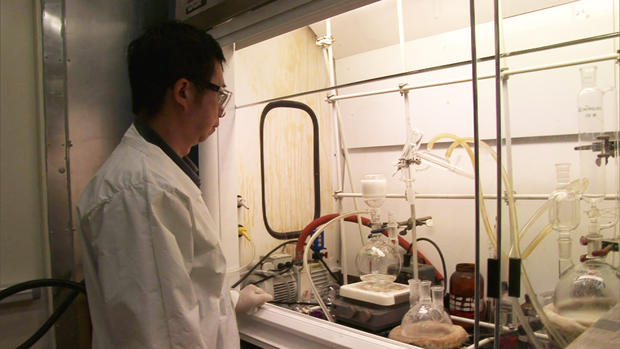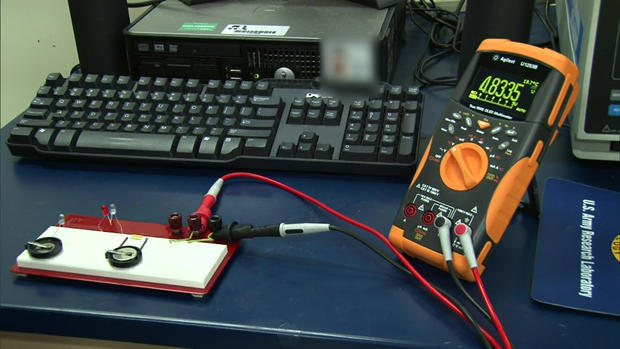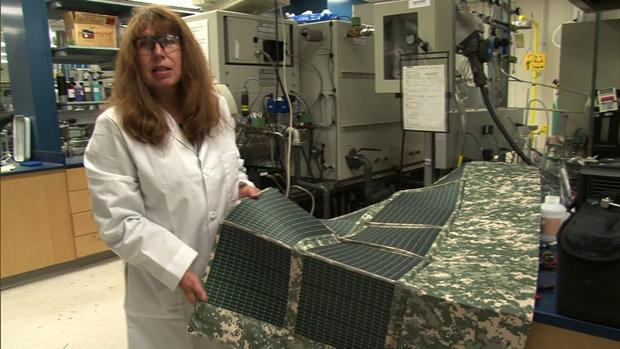Army scientists max out battery power to save soldiers' lives
ADELPHI, Md. U.S. soldiers carry an average of almost 100 pounds of equipment in the field, including between 19-and-30 pounds of batteries. At the Army Research Lab in Adelphi, Md., scientists are trying to lighten that load - as well as the military's carbon footprint.
"Energy density, how long the battery lasts, is a direct function of the voltage," said Cynthia Lundgren, chief of the lab's electrochemistry branch. Noting that typical state-of-the-art lithium ion batteries produce 3.8 to 4.2 volts, she continued, "If we could get a 5-volt battery, then we could increase density by 30 percent, and lighten the load of the soldier by that much."
Despite the odds, they've done it. Showing CBSNews.com around the lab's "dry room" - which keeps humidity below .005 percent, enabling researchers to work with moisture-sensitive materials - Lundgren explained that her electrochemistry branch has developed an additive to stabilize the ever-reacting interface between electrodes and electrolytes in higher-voltage batteries.
Another factor they have to control for is temperature. "At the Department of Defense, our batteries need to operate at a wide temperature range, and have to be safe in a ballistic environment," Lundgren said, adding that their batteries must be durable between -40 to 55 degrees Celsius.
The additives also enable batteries to survive more charging cycles before they're considered dead. Demonstrating a five-volt stable battery - the first of its kind - Arthur Cresce, a materials scientist at the lab, said it can endure hundreds of charges before dipping below 80 percent of its initial capacity.
"We can discharge the battery, recharge it - we can do it hundreds of times," he said. "And so part of stability is not just being able to do it once or twice but being able to do it a lot."
Rechargeable batteries that can be purchased at a local pharmacy could very well feature the lighter, longer-lasting materials created by the scientists in several years. Right now, the lab is working with industry - Saft America and the NEI Corporation - to scale up their models in order to test them on what Lundgren said would be "a more realistic-type battery," on pace to be delivered before the end of fiscal year 2014.
"We yet do not know if this chemistry is safer," she said. "We need bigger batteries to be able to tell that."
Meanwhile, her team is working on multiple short- and long-term projects that would keep soldiers self-sustaining on the battlefield. "Resupplying the soldier, resupplying the forward-operating bases," she said, "is very expensive - both in fuel and, especially, soldier lives."
One work-in-progress is the fuel cell for portable power. Though, due to peripheral outfits, they've "never been able to get it small enough to run on the soldier itself," Lundgren said, a fuel cell on a base can charge an entire squad's batteries. And through a contract with the Defense Advanced Research Projects Agency (DARPA), the lab is working on creating a fuel cell that runs on propane to power drones.
"They have demonstrated extended flight time, from two hours with batteries to eight hours with a fuel cell and propane," Lundgren said. "And that's remarkable."
Of course, when talking about alternative energy, you can't forget the sun. "The soldiers love their solar power," Lundgren said, adding that while the Department of Energy is "looking for large solar" power, the Pentagon is "looking for portable solar."
Protonex, one of the lab's contractors, is in its early phases of selling to PEO Soldier its "Power Manager," which combines energy drawn from a fuel cell and a solar blanket to provide power in some of the most remote places in the world. "You can run your laptop off of it, you can charge a whole bunch of different batteries off of this - it has cables for everything," Lundgren said. "The soldiers love these."
The Army only started weaning off primary batteries in favor of rechargeable ones during the war in Afghanistan. But with 50 percent of troops now fully reliant on them, Lundgren said, the lab further down the road hopes to use its research to create a fuel product that would replace batteries and charging devices in the battlefield altogether.
"We want to take sunlight, water, carbonaceous waste, and make liquid fuel," she said. "Solar is great, except that you can't store it at night. That's why you have batteries, so you solar charge your batteries. If we can use that solar and convert it to liquid fuel, the fuel can be stored."
Lundgren said that, in freeing up the capacity for soldiers to carry more water or ammunition, her team is motivated largely by one thing: "Knowing that they're coming to work every day and that someday they might save the life of a soldier."



